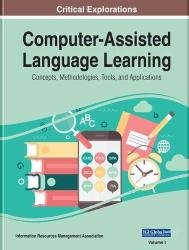 Название: Computer-Assisted Language Learning: Concepts, Methodologies, Tools, and Applications, 4 Volume Set
Название: Computer-Assisted Language Learning: Concepts, Methodologies, Tools, and Applications, 4 Volume SetАвтор: MehdiKhosrow-Pour [Editor]
Издательство: IGI Global
Год: 2019
Страниц: 2231
Язык: английский
Формат: pdf (true)
Размер: 54.9 MB
In a diverse society, the ability to cross communication barriers is critical to the success of any individual personally, professionally, and academically. With the constant acceleration of course programs and technology, educators are continually being challenged to develop and implement creative methods for engaging English-speaking and non-English-speaking learners.
The constantly changing landscape of Computer-Assisted Language Learning makes it challenging for experts and practitioners to stay informed of the field’s most up-to-date research. That is why Information Science Reference is pleased to offer this four-volume reference collection that will empower students, researchers, and academicians with a strong understanding of critical issues within Computer-Assisted Language Learning by providing both broad and detailed perspectives on cutting-edge theories and developments. This reference is designed to act as a single reference source on conceptual, methodological, technical, and managerial issues, as well as to provide insight into emerging trends and future opportunities within the discipline.
Computer-Assisted Language Learning: Concepts, Methodologies, Tools, and Applications is organized into seven distinct sections that provide comprehensive coverage of important topics. The sections are:
1. Fundamental Concepts and Theories;
2. Development and Design Methodologies;
3. Tools and Technologies;
4. Utilization and Applications;
5. Organizational and Social Implications;
6. Critical Issues and Challenges; and
7. Emerging Trends.
The following paragraphs provide a summary of what to expect from this invaluable reference tool.
Section 1, “Fundamental Concepts and Theories,” serves as a foundation for this extensive reference tool by addressing crucial theories essential to the understanding of Computer-Assisted Language Learning. Introducing the book is “An Overview of EFL Teachers' Individual Differences in CALL” by Samaneh Yadollahi: a great foundation laying the groundwork for the basic concepts and theories that will be discussed throughout the rest of the book. Section 1 concludes and leads into the following portion of the book with a nice segue chapter, “Local Norms in CALL Language Practice” by Jonathan R. White.
Section 2, “Development and Design Methodologies,” presents in-depth coverage of the conceptual design and architecture of Computer-Assisted Language Learning. Opening the section is “Improve the Flipped Classroom With Universal Design for Learning” by Thomas J. Tobin and Barbi Honeycutt. Through case studies, this section lays excellent groundwork for later sections that will get into present and future applications for Computer-Assisted Language Learning. The section concludes with an excellent work by Vehbi Turel, “Intelligent Design of the Post-Listening Tasks in Interactive Multimedia Listening Environments.”
Section 3, “Tools and Technologies,” presents extensive coverage of the various tools and technologies used in the implementation of Computer-Assisted Language Learning. The first chapter, “The Effectiveness of Multiple Media Tools in L2 Listening: A Meta-Analysis” by Tingting Kang, lays a framework for the types of works that can be found in this section. The section concludes with “Mobile-Assisted Language Learning Experiences” by Daesang Kim, Daniel Ruecker, and Dong-Joong Kim. Where Section 3 described specific tools and technologies at the disposal of practitioners, Section 4 describes the use and applications of the tools and frameworks discussed in previous sections.
Section 4, “Utilization and Applications,” describes how the broad range of Computer-Assisted Language Learning efforts has been utilized and offers insight on and important lessons for their applications and impact. The first chapter in the section is “Using the Flipped Classroom to Improve Knowledge Creation of Master's-Level Students in Engineering” written by Sachin Ahuja. This section includes the widest range of topics because it describes case studies, research, methodologies, frameworks, architectures, theory, analysis, and guides for implementation. The breadth of topics covered in the section is also reflected in the diversity of its authors, from countries all over the globe. The section concludes with “Learning Language Through Facebook” by Vera Monika Leier, a great transition chapter into the next section...
Скачать Computer-Assisted Language Learning: Concepts, Methodologies, Tools, and Applications, 4 Volume Set